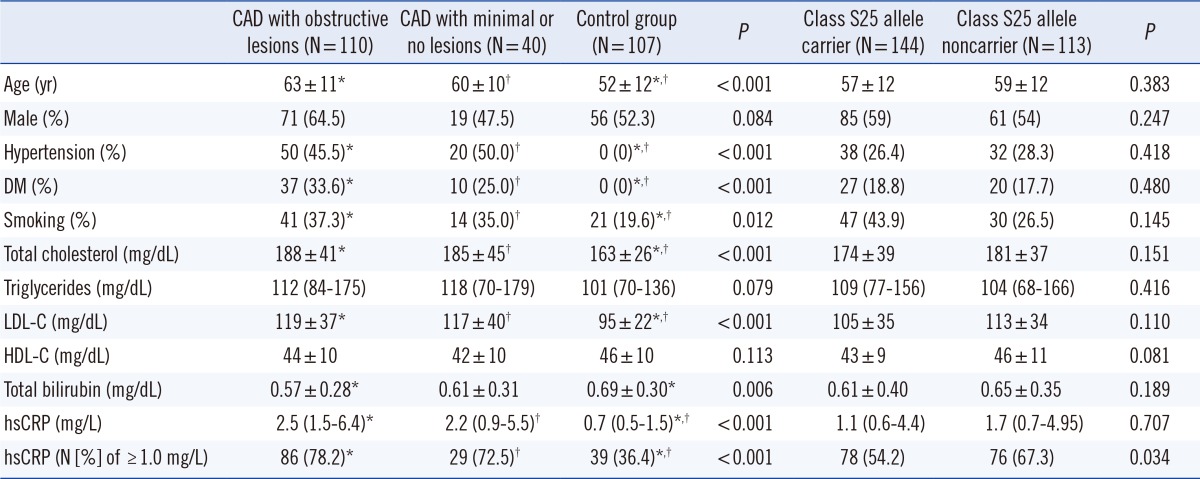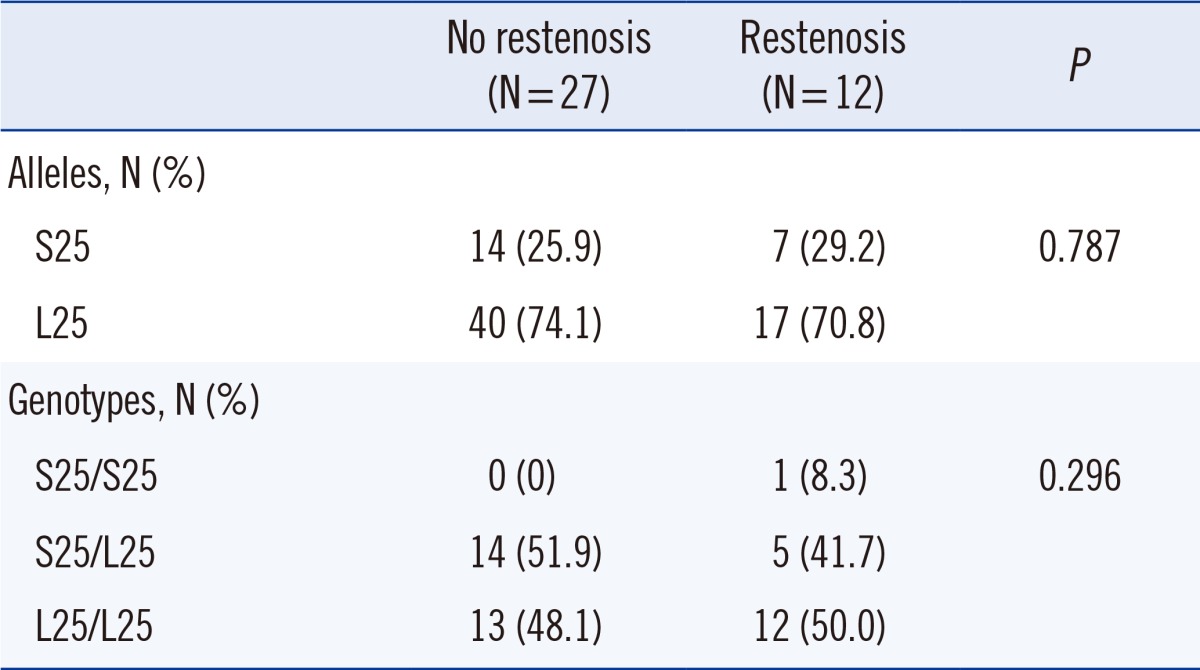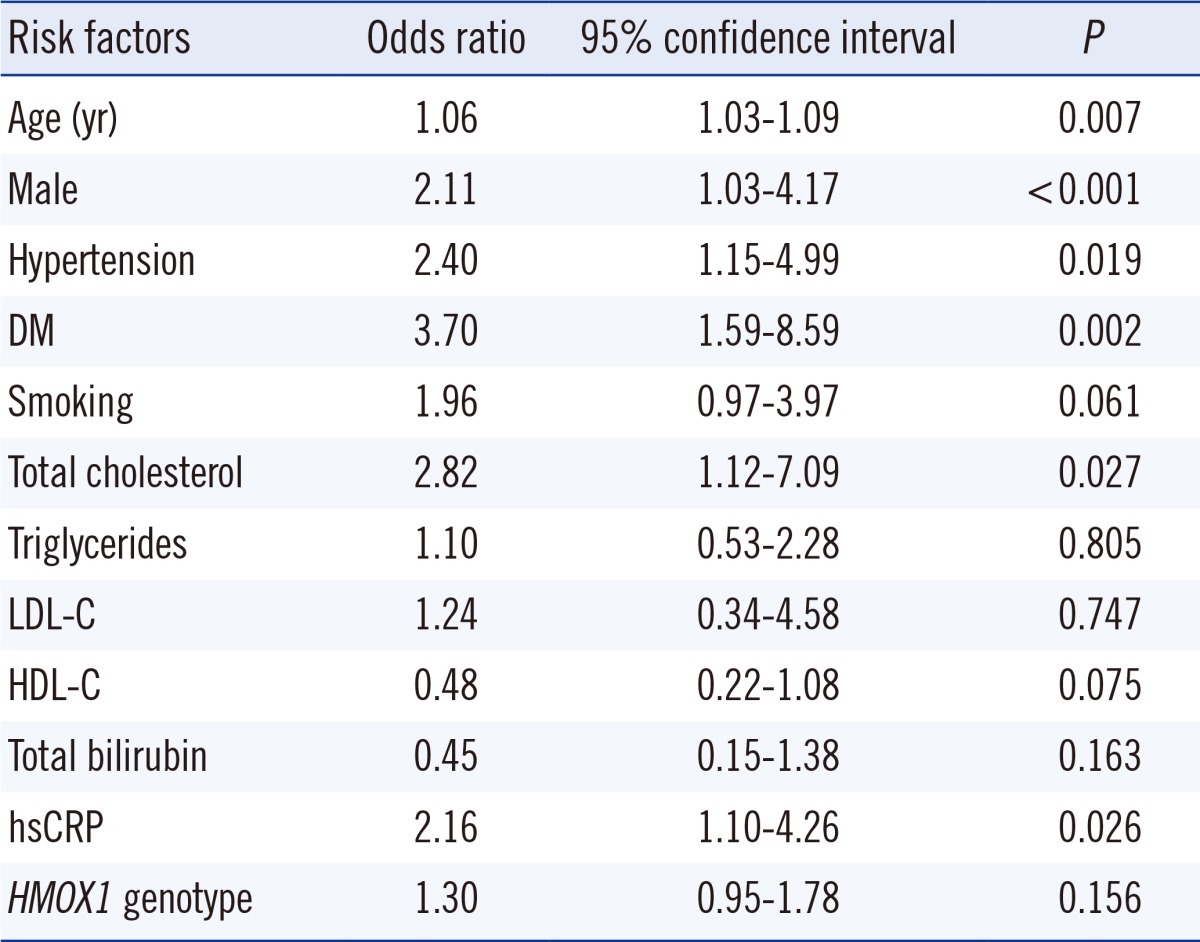1. Berliner JA, Navab M, Fogelman AM, Frank JS, Demer LL, Edwards PA, et al. Atherosclerosis: basic mechanism.Oxidation, inflammation, and genetics. Circulation. 1995; 91:2488–2496.
2. Lusis AJ. Atherosclerosis. Nature. 2000; 407:233–241. PMID:
11001066.

3. Jornot L, Junod AF. Variable glutathione levels and expression of antioxidant enzymes in human endothelial cells. Am J Physiol. 1993; 264:L482–L489. PMID:
8498525.

4. Maines MD. Hemeoxygenase: function, multiplicity, regulatory mechanisms, and clinical applications. FASEB J. 1988; 2:2557–2568. PMID:
3290025.
5. Ishikawa K, Sugawara D, Wang XP, Suzuki K, Itabe H, Maruyama Y, et al. Heme oxygenase-1 inhibits atherosclerotic lesion formation in LDL-receptor knockout mice. Circ Res. 2001; 88:506–512. PMID:
11249874.

6. Ryter SW, Kim HP, Nakahira K, Zuckerbraun BS, Morse D, Choi AM. Protective functions of heme oxygenase-1 and carbon monoxide in the respiratory system. Antioxid Redox Signal. 2007; 9:2157–2173.

7. Exner M, Schillinger M, Minar E, Mlekusch W, Schlerka G, Haumer M, et al. Heme oxygenase-1 gene promoter microsatellite polymorphism is associated with restenosis after percutaneous transluminal angioplasty. J Endovasc Ther. 2001; 8:433–440. PMID:
11718398.

8. Ono K, Goto Y, Takagi S, Baba S, Tago N, Nonogi H, et al. A promoter variant of the heme oxygenase-1 gene may reduce the incidence of ischemic heart disease in Japanese. Atherosclerosis. 2004; 173:315–319.

9. Kaneda H, Ohno M, Taguchi J, Togo M, Hashimoto H, Ogasawara K, et al. Heme oxygenase-1 gene promoter polymorphism is associated with coronary artery disease in Japanese patients with coronary risk factors. Arterioscler Thromb Vasc Biol. 2002; 22:1680–1685. PMID:
12377749.

10. Schillinger M, Exner M, Mlekusch W, Ahmadi R, Rumpold H, Mannhalter C, et al. Heme oxygenase-1 genotype is a vascular anti-inflammatory factor following balloon angioplasty. J Endovasc Ther. 2002; 9:385–394.

11. Schillinger M, Exner M, Minar E, Mlekusch W, Müllner M, Mannhalter C, et al. Heme oxygenase-1 genotype and restenosis after balloon angioplasty: a novel vascular protective factor. J Am Coll Cardiol. 2004; 43:950–957. PMID:
15028349.

12. Chen YH, Chau LY, Lin MW, Chen LC, Yo MH, Chen JW, et al. Heme oxygenase-1 gene promotor microsatellite polymorphism is associated with angiographic restenosis after coronary stenting. Eur Heart J. 2004; 25:39–47.

13. Pearson TA, Mensah GA, Alexander RW, Anderson JL, Cannon RO 3rd, Criqui M, et al. Markers of inflammation and cardiovascular disease: application to clinical and public health practice: A statement for healthcare professionals from the Centers for Disease Control and Prevention and the American Heart Association. Circulation. 2003; 107:499–511. PMID:
12551878.
14. Hansson GK. Inflammation, atherosclerosis, and coronary artery disease. N Engl J Med. 2005; 352:1685–1695. PMID:
15843671.

15. Chen M, Zhou L, Ding H, Huang S, He M, Zhang X, et al. Short (GT) (n) repeats in heme oxygenase-1 gene promoter are associated with lower risk of coronary heart disease in subjects with high levels of oxidative stress. Cell Stress Chaperones. 2012; 17:329–338. PMID:
22120665.

16. Chen YH, Yet SF, Perrella MA. Role of heme oxygenase-1 in the regulation of blood pressure and cardiac function. Exp Biol Med (Maywood). 2003; 228:447–453.

17. Bai CH, Chen JR, Chiu HC, Chou CC, Chau LY, Pan WH. Shorter GT repeat polymorphism in the heme oxygenase-1 gene promoter has protective effect on ischemic stroke in dyslipidemia patients. J Biomed Sci. 2010; 17:12. PMID:
20175935.

18. Abraham NG, Kappas A. Hemeoxygenase and the cardiovascular-renal system. Free Radic Biol Med. 2005; 39:1–25.
19. Bozkaya OG, Kumral A, Yesilirmak DC, Ulgenalp A, Duman N, Ercal D, et al. Prolonged unconjugated hyperbilirubinaemia associated with the haem oxygenase-1 gene promoter polymorphism. Acta Paediatr. 2010; 99:679–683. PMID:
20121710.

20. Lee TS, Chang CC, Zhu Y, Shyy JY. Simvastatin induces heme oxygenase-1: a novel mechanism of vessel protection. Circulation. 2004; 110:1296–1302. PMID:
15337692.
21. Chen YH, Lin SJ, Lin MW, Tsai HL, Kuo SS, Chen JW, et al. Microsatellite polymorphism in promoter of heme oxygenase-1 gene is associated with susceptibility to coronary artery disease in type 2 diabetic patients. Hum Genet. 2002; 111:1–8. PMID:
12136229.
22. Gulesserian T, Wenzel C, Endler G, Sunder-Plassmann R, Marsik C, Mannhalter C, et al. Clinical restenosis after coronary stent implantation is associated with the heme oxygenase-1 gene promoter polymorphism and the heme oxygenase-1 +99 G/C variant. Clin Chem. 2005; 51:1661–1665.
23. Yamada N, Yamaya M, Okinaga S, Nakayama K, Sekizawa K, Shibahara S, et al. Microsatellite polymorphism in the heme oxygenase-1 gene promoter is associated with susceptibility to emphysema. Am J Hum Genet. 2000; 66:187–195.

24. Was H, Dulak J, Jozkowicz A. Hemeoxygenase-1 in tumor biology and therapy. Curr Drug Targets. 2010; 11:1551–1570.
25. Raval CM. Heme oxygenase-1 in lung disease. Curr Drug Targets. 2010; 11:1532–1540.
26. Kanai M, Akaba K, Sasaki A, Sato M, Harano T, Shibahara S, et al. Neonatal hyperbilirubinemia in Japanese neonates: analysis of the heme oxygenase-1 gene and fetal hemoglobin composition in cord blood. Pediatr Res. 2003; 54:165–171.

27. Chin HJ, Cho HJ, Lee TW, Na KY, Yoon HJ, Chae DW, et al. The heme oxygenase-1 genotype is a risk factor to renal impairment of IgA nephropathy at diagnosis, which is a strong predictor of mortality. J Korean Med Sci. 2009; 24(Suppl):S30–S37.

28. Funk M, Endler G, Schillinger M, Mustafa S, Hsieh K, Exner M, et al. The effect of a promoter polymorphism in the heme oxygenase-1 gene on the risk of ischaemic cerebrovascular events: the influence of other vascular risk factors. Thromb Res. 2004; 113:217–223.
29. Kimpara T, Takeda A, Watanabe K, Itoyama Y, Ikawa S, Watanabe M, et al. Microsatellite polymorphism in the human heme oxygenase-1 gene promoter and its application in association studies with Alzheimer and Parkinson disease. Hum Genet. 1997; 100:145–147.

30. Endler G, Exner M, Schillinger M, Marculescu R, Sunder-Plassmann R, Raith M, et al. A microsatellite polymorphism in the heme oxygenase-1 gene promoter is associated with increased bilirubin and HDL levels but not with coronary artery disease. Thromb Haemost. 2004; 91:155–161.

31. Li P, Sanders J, Hawe E, Brull D, Montgomery H, Humphries S. Inflammatory response to coronary artery bypass surgery: does the heme-oxygenase-1 gene microsatellite polymorphism play a role? Chin Med J. 2005; 118:1285–1290.
32. Tiroch K, Koch W, von Beckerath N, Kastrati A, Schömig A. Heme oxygenase-1 gene promoter polymorphism and restenosis following coronary stenting. Eur Heart J. 2007; 28:968–973.







 PDF
PDF ePub
ePub Citation
Citation Print
Print





 XML Download
XML Download